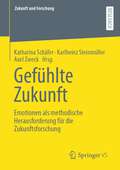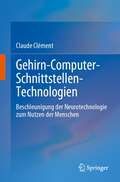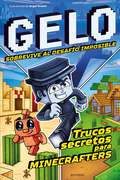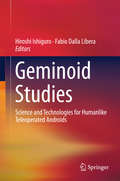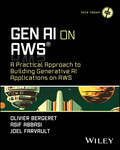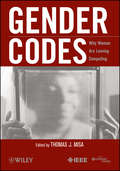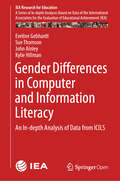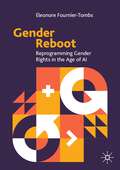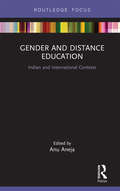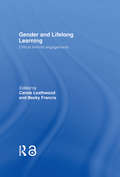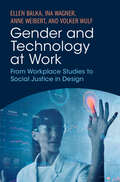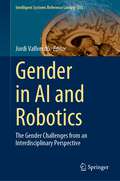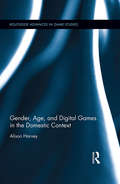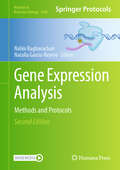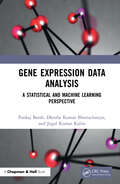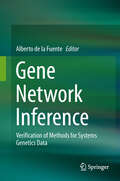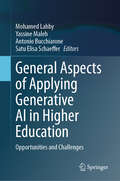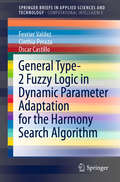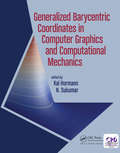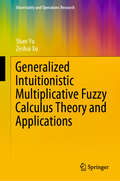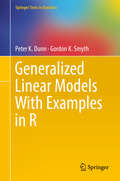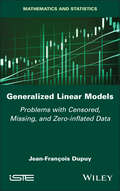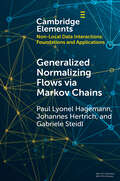- Table View
- List View
Gefühlte Zukunft: Emotionen als methodische Herausforderung für die Zukunftsforschung (Zukunft und Forschung)
by Axel Zweck Karlheinz Steinmüller Katharina SchäferWelche Rolle spielen Emotionen bei der Konstruktion, Kommunikation und Nutzung von Zukunftsbildern? Sind Emotionen primär eine Komponente, die Vorurteile transportiert? In welchem Maße sind Forschende selbst Emotionen ausgesetzt, die die Methodenwahl und die Ergebnisse beeinflussen? In dem Sammelband kommt die gesamte Breite der Thematik „Zukunftsforschung und Emotionalität“ zur Sprache, von den philosophischen Grundlagen bis zu methodischen Fragestellungen und Erkenntnissen aus der Praxis, die die enge Verschränkung von Kognition und Emotion in allen Phasen von Vorausschauprozessen belegen.
Gehirn-Computer-Schnittstellen-Technologien: Beschleunigung der Neurotechnologie zum Nutzen der Menschen
by Claude ClémentDieses Buch befasst sich mit dem Bereich der Gehirn-Computer-Schnittstellen (BCI) und dem einzigartigen und besonderen Umfeld aktiver Implantate, die eine elektrische Schnittstelle zum Gehirn, zum Rückenmark, zu peripheren Nerven und zu Organen bilden. Im Mittelpunkt des Buches steht die Heilung und Rehabilitation von Patienten mit schweren neurologischen Beeinträchtigungen, von Lähmungen bis hin zu Bewegungsstörungen und Epilepsie, die oft eine invasive Lösung auf der Grundlage eines implantierten Geräts erfordern. Frühere Errungenschaften, aktuelle Arbeiten und Zukunftsperspektiven von BCI und anderen Interaktionen zwischen medizinischen Geräten und dem menschlichen Nervensystem werden aus pragmatischer Sicht ausführlich beschrieben. gibt einen Überblick über die Branche der aktiven implantierbaren medizinischen Geräte (AIMDs) und wie sie sich von kardialen zu neurologischen Anwendungen entwickelt Klare, leicht zu lesende Darstellung des Bereichs der Neurotechnologien zum Nutzen des Menschen Bietet leicht verständliche Erklärungen zu den technischen Grenzen, den physikalischen Eigenschaften von Implantaten im menschlichen Körper und realistischen langfristigen Perspektiven
Gelo Sobrevive al desafío imposible: Trucos secretos para minecrafters
by GeloGelo tiene una misión importantísima... ¡tendrá que usar los mejores trucos de Minecraft para salvarlos a todos! EL COLECCIONISTA ha llegado a su aldea para hacerse con un objeto legendario poderosísimo y todos están en peligro: ¡se va a convertir en la criatura más fuerte del universo! Gelo sabe cómo pararle los pies y está dispuesto a todo, aunque eso implique tener que escalar montañas imposibles, luchar contra criaturas extrañas, escapar de bloques de hielo y enfrentarse al peor enemigo de todos los tiempos. Por suerte, contará con la ayuda de su nuevo amigo Gólem y con un libro especial lleno de trucos para sobrevivir a su misión. ¿CONSEGUIRÁN PARARLE LOS PIES AL COLECCIONISTA ANTES DE QUE SEA DEMASIADO TARDE? ATENCIÓN: ¡Este libro incluye los mejores trucos de Minecraft!
Geminoid Studies: Science And Technologies For Humanlike Teleoperated Androids
by Hiroshi Ishiguro Fabio Dalla LiberaThis book describes the teleoperated android Geminoid, which has a very humanlike appearance, movements, and perceptions, requiring unique developmental techniques. The book facilitates understanding of the framework of android science and how to use it in real human societies. Creating body parts of soft material by molding an existing person using a shape-memory form provides not only the humanlike texture of the body surface but also safe physical interaction, that is, humanlike interpersonal interaction between people and the android. The teleoperation also highlights novel effects in telecommunication. Operators of the Geminoid feel the robot's body as their own, and people encountering the teleoperated Geminoid perceive the robot's body as being possessed by the operator as well.Where does the feeling of human presence come from? Can we transfer or reproduce human presence by technology? Geminoid may help to answer these questions.
GenAI on AWS: A Practical Approach to Building Generative AI Applications on AWS (Tech Today)
by Asif Abbasi Olivier Bergeret Joel FarvaultThe definitive guide to leveraging AWS for generative AI GenAI on AWS: A Practical Approach to Building Generative AI Applications on AWS is an essential guide for anyone looking to dive into the world of generative AI with the power of Amazon Web Services (AWS). Crafted by a team of experienced cloud and software engineers, this book offers a direct path to developing innovative AI applications. It lays down a hands-on roadmap filled with actionable strategies, enabling you to write secure, efficient, and reliable generative AI applications utilizing the latest AI capabilities on AWS. This comprehensive guide starts with the basics, making it accessible to both novices and seasoned professionals. You'll explore the history of artificial intelligence, understand the fundamentals of machine learning, and get acquainted with deep learning concepts. It also demonstrates how to harness AWS's extensive suite of generative AI tools effectively. Through practical examples and detailed explanations, the book empowers you to bring your generative AI projects to life on the AWS platform. In the book, you'll: Gain invaluable insights from practicing cloud and software engineers on developing cutting-edge generative AI applications using AWS Discover beginner-friendly introductions to AI and machine learning, coupled with advanced techniques for leveraging AWS's AI tools Learn from a resource that's ideal for a broad audience, from technical professionals like cloud engineers and software developers to non-technical business leaders looking to innovate with AI Whether you're a cloud engineer, software developer, business leader, or simply an AI enthusiast, Gen AI on AWS is your gateway to mastering generative AI development on AWS. Seize this opportunity for an enduring competitive advantage in the rapidly evolving field of AI. Embark on your journey to building practical, impactful AI applications by grabbing a copy today.
Gena/Finn
by Hannah Moskowitz Kat HelgesonGena and Finn would have never met but for their mutual love for the popular show Up Below. Regardless of their differences—Gena is a recent high school graduate whose social life largely takes place online, while Finn is in her early twenties, job hunting and contemplating marriage with her longtime boyfriend—the two girls realize that the bond between them transcends fanfiction. When disaster strikes and Gena's world turns upside down, only Finn can save her, and that, too, comes with a price. Told through emails, text messages, journal entries, and blog posts, Gena/Finn is a story of friendship and love in the digital age.
Gender Codes: Why Women Are Leaving Computing
by Thomas J. MisaThe computing profession faces a serious gender crisis. Today, fewer women enter computing than anytime in the past 25 years. This book provides an unprecedented look at the history of women and men in computing, detailing how the computing profession emerged and matured, and how the field became male coded. Women's experiences working in offices, education, libraries, programming, and government are examined for clues on how and where women succeeded—and where they struggled. It also provides a unique international dimension with studies examining the U.S., Great Britain, Germany, Norway, and Greece. Scholars in history, gender/women's studies, and science and technology studies, as well as department chairs and hiring directors will find this volume illuminating.
Gender Differences in Computer and Information Literacy: An In-depth Analysis of Data from ICILS (IEA Research for Education #8)
by John Ainley Eveline Gebhardt Sue Thomson Kylie HillmanThis open access book presents a systematic investigation into internationally comparable data gathered in ICILS 2013. It identifies differences in female and male students’ use of, perceptions about, and proficiency in using computer technologies. Teachers’ use of computers, and their perceptions regarding the benefits of computer use in education, are also analyzed by gender. When computer technology was first introduced in schools, there was a prevailing belief that information and communication technologies were ‘boys’ toys’; boys were assumed to have more positive attitudes toward using computer technologies. As computer technologies have become more established throughout societies, gender gaps in students’ computer and information literacy appear to be closing, although studies into gender differences remain sparse. The IEA’s International Computer and Information Literacy Study (ICILS) is designed to discover how well students are prepared for study, work, and life in the digital age. Despite popular beliefs, a critical finding of ICILS 2013 was that internationally girls tended to score more highly than boys, so why are girls still not entering technology-based careers to the same extent as boys? Readers will learn how male and female students differ in their computer literacy (both general and specialized) and use of computer technology, and how the perceptions held about those technologies vary by gender.
Gender Reboot: Reprogramming Gender Rights in the Age of AI
by Eleonore Fournier-TombsThis book explores gender norms and women’s rights in the age of AI. The author examines how gender dynamics have evolved in the spheres of work, self-image and safety, and education, and how these might be reflected in current challenges in AI development. The book also explores opportunities in AI to address issues facing women, and how we might harness current technological developments for gender equality. Taking a narrative tone, the book is interwoven with stories and a reflection on the raising young children during the COVID-19 pandemic. It includes both expert and personal interviews to create a nuanced and multidimensional perspective on the state of women’s rights and what might be done to move forward.
Gender and Distance Education: Indian and International Contexts
by Anu AnejaThis book investigates the intersection of gender and distance education from a feminist perspective and explores their contemporary innovative interfaces in Indian and international contexts. The key issues raised here include a re- investigation of the democratizing potential of distance education from a gendered perspective (especially in developing countries such as India), feminist pedagogical perspectives on the notion of transactional distance, the relationship between masculinity and gerontology from the perspective of non- traditional modes, and the interrelationships between gender and social media from a distance education perspective. As opposed to the conventional, physical classroom, the virtual classroom often occupies a de- privileged space in feminist pedagogical discussions, since it appears to align itself less easily with feminist praxes which encourage a free, intellectual exchange between teachers and students. By opening up various facets of the relationship between gender, distance education and feminist pedagogy, the book foregrounds the critical need to re- visit preconceived, unfavourable assumptions about this relationship and proposes mutually productive inter-linkages. It does so in the context of contemporary circumstances defined by the increasing use of virtual technology, the ongoing need for democratization of higher education and the constraints posed by consumerist trends. Lucid and topical, this Focus volume will be useful to scholars and researchers of higher education, open and distance education, feminist pedagogy, gender studies, feminism, masculinity, and women’s studies as well as practitioners and policymakers working in the education sector.
Gender and Lifelong Learning: Critical Feminist Engagements
by Becky Francis Carole LeathwoodThis insightful book is ideal for students, researchers and policy makers wanting a sound overview of the critical issues of gender in lifelong learning. Asking pertinent questions relating to discourses on policy, the authors offer the reader a rare view of lifelong learning from a gender-focused perspective, filling a gap in the literature and moving current debate on into new areas. Questions addressed include: To what extent can the policy discourses and institutional contexts of lifelong learning be seen as masculinised and/or feminised? What are the gender implications of lifelong learning policy? In what ways are learners’ identities constructed through lifelong learning? Does lifelong learning provide opportunities to challenge or transgress gender binaries? What are the implications for practice?
Gender and Technology at Work: From Workplace Studies to Social Justice in Design
by Ellen Balka Ina Wagner Anne Weibert Volker WulfThis book brings together the vast research literature about gender and technology to help designers understand what a gender perspective and a focus on intersectionality can contribute to designing information technology systems and artifacts, and to assist organizations as they work to develop work cultures that are supportive of women and marginalized genders and people. Drawing on empirical and analytical studies of women's work and technology in many parts of the world, the book addresses how to make invisible aspects of work visible; how to recognize women's skills without falling into the trap of gender stereotyping; how to engage in improving working conditions; and how to defend care of life situations and needs against a managerial logic. It addresses challenges for design, including many overlooked and undervalued aspects, such as the complexities involved in human–machine interactions, as well as the need to create safe spaces for research subjects.
Gender in AI and Robotics: The Gender Challenges from an Interdisciplinary Perspective (Intelligent Systems Reference Library #235)
by Jordi VallverdúWhy AI does not include gender in its agenda? The role of gender in AI, both as part of the community of agents creating such technologies, as well as part of the contents processed by such technologies is, by far, conflictive. Women have been, again, obliterated by this fundamental revolution of our century. Highly innovative and the first step in a series of future studies in this field, this book covers several voices, topics, and perspectives that allow the reader to understand the necessity to include into the AI research agenda such points of view and also to attract more women to this field. The multi-disciplinarity of the contributors, which uses plain language to show the current situation in this field, is a fundamental aspect of the value of this book. Any reader with a genuine interest in the present and future of AI should read it.
Gender, Age, and Digital Games in the Domestic Context (Routledge Advances in Game Studies)
by Alison HarveyWestern digital game play has shifted in important ways over the last decade, with a plethora of personal devices affording a range of increasingly diverse play experiences. Despite the celebration of a more inclusive environment of digital game play, very little grounded research has been devoted to the examination of familial play and the domestication of digital games, as opposed to evolving public and educational contexts. This book is the first study to provide a situated investigation of the site of family play— the shared spaces and private places of gameplay within the domestic sphere. It carries out an empirically grounded and critical analysis of what marketing and sales discourses about shifts in the digital games audience actually look like in the space of the home, as well as the social and cultural role these ludic technologies take in the everyday practices of the family in the domestic context. It examines the material realities of video game technologies in the home; including time management and spatial organization, as well as the discursive role these devices play in discussions of technological competence and its complex relationship to age, generational differences, and gender performance. Harvey’s interdisciplinary approach and innovative methodology will hold great critical appeal for those studying digital culture, children’s media, and feminist studies of new media, as well as critical theories of technology and leisure and sport theory.
Gene Expression Analysis: Methods and Protocols (Methods in Molecular Biology #2880)
by Nalini Raghavachari Natalia Garcia-ReyeroThis second edition volume expands on the previous edition with updates on the latest methodologies in the transcriptomics field. The chapters in this book cover topics such as spatial omics, long-read sequencing technology, tissue microarrays, analysis of saliva and extracellular vesicles, machine learning and artificial intelligence-based approaches for analysis of singe cells transcriptome, and large sets of data on multi-omics including transcriptomics. Written in the highly successful Methods in Molecular Biology series format, chapters include introductions to their respective topics, lists of the necessary materials and reagents, step-by-step, readily reproducible laboratory protocols, and tips on troubleshooting and avoiding known pitfalls. Cutting-edge and practical, Gene Expression Analysis: Methods and Protocols, Second Edition is a valuable resource for advanced undergraduate and graduate students studying gene expression analysis, and scientists interested in learning more about this rapidly advancing field.
Gene Expression Data Analysis: A Statistical and Machine Learning Perspective
by Dhruba Kumar Bhattacharyya Jugal Kumar Kalita Pankaj BarahDevelopment of high-throughput technologies in molecular biology during the last two decades has contributed to the production of tremendous amounts of data. Microarray and RNA sequencing are two such widely used high-throughput technologies for simultaneously monitoring the expression patterns of thousands of genes. Data produced from such experiments are voluminous (both in dimensionality and numbers of instances) and evolving in nature. Analysis of huge amounts of data toward the identification of interesting patterns that are relevant for a given biological question requires high-performance computational infrastructure as well as efficient machine learning algorithms. Cross-communication of ideas between biologists and computer scientists remains a big challenge. Gene Expression Data Analysis: A Statistical and Machine Learning Perspective has been written with a multidisciplinary audience in mind. The book discusses gene expression data analysis from molecular biology, machine learning, and statistical perspectives. Readers will be able to acquire both theoretical and practical knowledge of methods for identifying novel patterns of high biological significance. To measure the effectiveness of such algorithms, we discuss statistical and biological performance metrics that can be used in real life or in a simulated environment. This book discusses a large number of benchmark algorithms, tools, systems, and repositories that are commonly used in analyzing gene expression data and validating results. This book will benefit students, researchers, and practitioners in biology, medicine, and computer science by enabling them to acquire in-depth knowledge in statistical and machine-learning-based methods for analyzing gene expression data. Key Features: An introduction to the Central Dogma of molecular biology and information flow in biological systems A systematic overview of the methods for generating gene expression data Background knowledge on statistical modeling and machine learning techniques Detailed methodology of analyzing gene expression data with an example case study Clustering methods for finding co-expression patterns from microarray, bulkRNA, and scRNA data A large number of practical tools, systems, and repositories that are useful for computational biologists to create, analyze, and validate biologically relevant gene expression patterns Suitable for multidisciplinary researchers and practitioners in computer science and biological sciences
Gene Network Inference
by Alberto FuenteThis book presents recent methods for Systems Genetics (SG) data analysis, applying them to a suite of simulated SG benchmark datasets. Each of the chapter authors received the same datasets to evaluate the performance of their method to better understand which algorithms are most useful for obtaining reliable models from SG datasets. The knowledge gained from this benchmarking study will ultimately allow these algorithms to be used with confidence for SG studies e. g. of complex human diseases or food crop improvement. The book is primarily intended for researchers with a background in the life sciences, not for computer scientists or statisticians.
General Aspects of Applying Generative AI in Higher Education: Opportunities and Challenges
by Antonio Bucchiarone Yassine Maleh Mohamed Lahby Satu Elisa SchaefferThis book explores the transformative impact of generative artificial intelligence (GenAI) on teaching and learning, examining how recent advancements in GenAI are revolutionizing educational practices across disciplines. The book is organized into three parts: an overview of GenAI in education, its application in diverse educational contexts, and future perspectives on how educators and GenAI can interface. The first part addresses the pressing concerns within the educational landscape, both the bridges GenAI allows us to build and the remaining as well as the emerging gaps. The middle part explores specific academic disciplines, such as history, sports medicine, mathematics, engineering, and the humanities, dissecting the influence of GenAI on each. The final part looks ahead, discussing the ethical implications, the evolving role of prompting, and innovative frameworks for personalized learning. By presenting a balanced view of the opportunities that are now within reach through GenAI and the challenges such leaps pose to the way we learn and teach, this book allows interested educators to learn from the early-adopting contributors to fruitfully and responsibly integrate such technologies into their pedagogical practices. It serves as a resource for anyone interested in the future of educational practices and research of education, offering insights that can spark further exploration and discussion within the academic community and educational policy makers.
General Type-2 Fuzzy Logic in Dynamic Parameter Adaptation for the Harmony Search Algorithm (SpringerBriefs in Applied Sciences and Technology)
by Oscar Castillo Fevrier Valdez Cinthia PerazaThis book focuses on the fields of fuzzy logic and metaheuristic algorithms, particularly the harmony search algorithm and fuzzy control. There are currently several types of metaheuristics used to solve a range of real-world of problems, and these metaheuristics contain parameters that are usually fixed throughout the iterations. However, a number of techniques are also available that dynamically adjust the parameters of an algorithm, such as probabilistic fuzzy logic.This book proposes a method of addressing the problem of parameter adaptation in the original harmony search algorithm using type-1, interval type-2 and generalized type-2 fuzzy logic. The authors applied this methodology to the resolution of problems of classical benchmark mathematical functions, CEC 2015, CEC2017 functions and to the optimization of various fuzzy logic control cases, and tested the method using six benchmark control problems – four of the Mamdani type: the problem of filling a water tank, the problem of controlling the temperature of a shower, the problem of controlling the trajectory of an autonomous mobile robot and the problem of controlling the speed of an engine; and two of the Sugeno type: the problem of controlling the balance of a bar and ball, and the problem of controlling control the balance of an inverted pendulum. When the interval type-2 fuzzy logic system is used to model the behavior of the systems, the results show better stabilization because the uncertainty analysis is better. As such, the authors conclude that the proposed method, based on fuzzy systems, fuzzy controllers and the harmony search optimization algorithm, improves the behavior of complex control plants.
General Will 2.0
by John Person Hiroki AzumaAccording to Azuma, the collective will and the general social contract has changed the world's political landscape over the last couple of years. Azuma looks back at Rousseau and Freud then forward to Twitter and Google to express how man deals with their part of the collective will through time. Azuma challenges society's perceptions of general will by looking at three philosophies through both time and technology. Azuma's unique analysis can be as compelling as fiction while making readers feel enlightened in the process.
Generalized Barycentric Coordinates in Computer Graphics and Computational Mechanics
by N. Sukumar Kai HormannIn Generalized Barycentric Coordinates in Computer Graphics and Computational Mechanics, eminent computer graphics and computational mechanics researchers provide a state-of-the-art overview of generalized barycentric coordinates. Commonly used in cutting-edge applications such as mesh parametrization, image warping, mesh deformation, and finite as well as boundary element methods, the theory of barycentric coordinates is also fundamental for use in animation and in simulating the deformation of solid continua. Generalized Barycentric Coordinates is divided into three sections, with five chapters each, covering the theoretical background, as well as their use in computer graphics and computational mechanics. A vivid 16-page insert helps illustrating the stunning applications of this fascinating research area. <P><P>Key Features: <li>Provides an overview of the many different types of barycentric coordinates and their properties. <li>Discusses diverse applications of barycentric coordinates in computer graphics and computational mechanics. <li>The first book-length treatment on this topic
Generalized Intuitionistic Multiplicative Fuzzy Calculus Theory and Applications (Uncertainty and Operations Research)
by Zeshui Xu Shan YuThis book mainly introduces the latest development of generalized intuitionistic multiplicative fuzzy calculus and its application. The book pursues three major objectives: (1) to introduce the calculus models with concrete mathematical expressions for generalized intuitionistic multiplicative fuzzy information; (2) to introduce new information fusion methods based on the definite integral models; and (3) to clarify the involved approaches bymilitary case. The book is especially valuable for readers to understand how the theoretical framework of generalized intuitionistic multiplicative fuzzy calculus is constructed, not only discrete or continuous but also correlative (generalized) intuitionistic (multiplicative) fuzzy information is aggregated based on the definite integral models and the theory with a military practice is integrated, which would deepen the understanding and give researchers more inspiration in practical decision analysis under uncertainties.
Generalized Linear Models With Examples in R (Springer Texts in Statistics)
by Peter K. Dunn Gordon K. SmythThis textbook presents an introduction to multiple linear regression, providing real-world data sets and practice problems. A practical working knowledge of applied statistical practice is developed through the use of these data sets and numerous case studies. The authors include a set of practice problems both at the end of each chapter and at the end of the book. Each example in the text is cross-referenced with the relevant data set, so that readers can load the data and follow the analysis in their own R sessions. The balance between theory and practice is evident in the list of problems, which vary in difficulty and purpose.This book is designed with teaching and learning in mind, featuring chapter introductions and summaries, exercises, short answers, and simple, clear examples. Focusing on the connections between generalized linear models (GLMs) and linear regression, the book also references advanced topics and tools that have not typically been included in introductions to GLMs to date, such as Tweedie family distributions with power variance functions, saddlepoint approximations, likelihood score tests, modified profile likelihood, and randomized quantile residuals. In addition, the authors introduce the new R code package, GLMsData, created specifically for this book. Generalized Linear Models with Examples in R balances theory with practice, making it ideal for both introductory and graduate-level students who have a basic knowledge of matrix algebra, calculus, and statistics.
Generalized Linear Models: Problems with Censored, Missing, and Zero-inflated Data (ISTE Invoiced)
by Jean-Francois DupuySince they were first formulated in 1972, generalized linear models have enjoyed a veritable boom, with numerous applications in insurance, economics and biostatistics. Today, they are still the subject of a great deal of research. This book provides an overview of the theory of generalized linear models. Particular attention is paid to the problems of censoring, missing data and excess zeros. Didactic and accessible, Generalized Linear Models is illustrated with exercises and numerous R codes. With all the necessary prerequisites introduced in a step-by-step fashion, this book is aimed at students (at master's or engineering school level), as well as teachers and practitioners of mathematics and statistical modeling.
Generalized Normalizing Flows via Markov Chains (Elements in Non-local Data Interactions: Foundations and Applications)
by Gabriele Steidl Paul Lyonel Hagemann Johannes HertrichNormalizing flows, diffusion normalizing flows and variational autoencoders are powerful generative models. This Element provides a unified framework to handle these approaches via Markov chains. The authors consider stochastic normalizing flows as a pair of Markov chains fulfilling some properties, and show how many state-of-the-art models for data generation fit into this framework. Indeed numerical simulations show that including stochastic layers improves the expressivity of the network and allows for generating multimodal distributions from unimodal ones. The Markov chains point of view enables the coupling of both deterministic layers as invertible neural networks and stochastic layers as Metropolis-Hasting layers, Langevin layers, variational autoencoders and diffusion normalizing flows in a mathematically sound way. The authors' framework establishes a useful mathematical tool to combine the various approaches.
